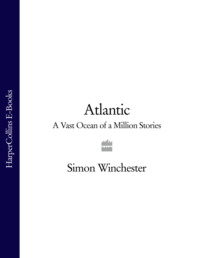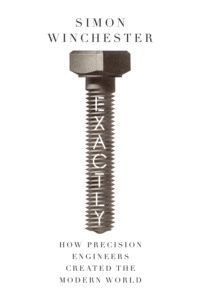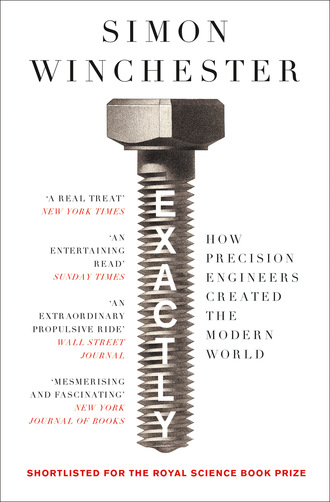
Полная версия
Exactly
THE ANTIKYTHERA MECHANISM, then, was a device remarkable and precise in its making and aspect, but its inaccuracy and understandably amateurish construction rendered it unreliable and, in practical terms, well-nigh useless. John Harrison’s timekeepers, though, were both precise and accurate, but given that they took years to make and perfect, and were the result of hugely costly craftsmanship, it would be idle to declare them either as candidates or as the fountainhead for true and world-changing precision. Also, though intending no disrespect to an indelible technical achievement, it is worth noting that John Harrison’s clockworks enjoyed perhaps only three centuries’ worth of practical usefulness. Nowadays, the brassbound chronometer in a ship’s chart room, just like the sextant kept in its watertight morocco box, is a thing more decorative than essential. Time signals of impeccable accuracy now come across the radio. The digital readout of longitude and latitude coordinates come to a ship’s bridge from a Global Positioning System’s (GPS) interrogation of faraway satellites. Clockwork machines, however beautifully their gears may be cut and enclosed in casings, however precious and intricately engraved, are a creation of yesterday’s technology, and are retained nowadays by and large for their precautionary value only: if the seagoing vessel loses all power, or if the master is a purist with a disdain for technology, then John Harrison’s works have real practical worth. Otherwise, his clocks gather dust and salt, or are kept in glass cases, and his name will begin to slip gradually astern, to vanish inevitably and soon in a sea fret of history, way stations at the beginning of the voyage.
For precision to be a phenomenon that would entirely alter human society, as it undeniably has done and will do for the foreseeable future, it has to be expressed in a form that is duplicable; it has to be possible for the same precise artifact to be made again and again with comparative ease and at a reasonable frequency and cost. Any true and knowledgeable craftsman (just like John Harrison) may be able, if equipped with sufficient skill, ample time, and tools and material of quality, to make one thing of elegance and evident precision. He may even make three or four or five of the same thing. And all will be beautiful, and most will inspire awe.
Large cabinets in museums devoted to the history of science (most notably at Oxford and Cambridge and Yale) are today filled with such objects. There are astrolabes and orreries, armillary spheres and astraria, octants and quadrants, and formidably elaborate sextants, both mural and framed, which are to be seen in particular abundance, most of them utterly exquisite, intricate, and assembled with a jeweler’s care.
At the same time, all of each instrument was perforce made by hand. Every gear was hand-cut, as was every component part (every mater and rete and tympan and alidade, for example; astrolabes have their own quite large vocabulary), every tangent screw and index mirror (words relating to sextants are similarly various). Also, the assembly of each part to every other and the adjustment of the assembled whole—all had to be accomplished with, quite literally, fingertip care. Such an arrangement produced fine and impressive instruments, without a doubt, but given the manner in which they were made and how they were put together, they could necessarily have been available only in rather limited numbers and to a small corps d’élite of customers. They may have been precise, but their precision was very much for the few. It was only when precision was created for the many that precision as a concept began to have the profound impact on society as a whole that it does today.
And the man who accomplished that single feat, of creating something with great exactitude and making it not by hand but with a machine, and, moreover, with a machine that was specifically created to create it—and I repeat the word created quite deliberately, because a machine that makes machines, known today as a “machine tool,” was, is, and will long remain an essential part of the precision story—was the eighteenth-century Englishman denounced for his supposed lunacy because of his passion for iron, the then-uniquely suitable metal from which all his remarkable new devices could be made.
IN 1776, THE forty-eight-year-old John Wilkinson, who would make a singular fortune during his eighty years of life, had his portrait painted by Thomas Gainsborough, so he is far from an uncelebrated figure—but if not uncelebrated, then not exactly celebrated, either. It is notable that his handsome society portrait has for decades hung not in prominence in London or Cumbria, where he was born in 1728, but in a quiet gallery in a museum far away in Berlin, along with four other Gainsboroughs, one of them a study of a bulldog. The distance suggests a certain lack of yearning for him back in his native England. And the New Testament remark about a prophet being without honor in his own country would seem to apply in his case, as Wilkinson is today rather little remembered. He is overshadowed quite comprehensively by his much-better-known colleague and customer, the Scotsman James Watt, whose early steam engines came into being, essentially, by way of John Wilkinson’s exceptional technical skills.
History will show that the story of such engines, which were so central to the mechanics of the following century’s Industrial Revolution, is inextricably entwined with that of the manufacture of cannons, and not simply because both men used components made from heavy hunks of iron. A further link can be made, between the thus gun-connected Wilkinson and Watt on the one hand and the clockmaker John Harrison on the other, as it will be remembered that Harrison’s early sea clock trials were made on Royal Naval warships of the day, warships that carried cannon in large numbers. Those cannons were made by English ironmasters, of whom John Wilkinson was among the most prominent and, as it turned out, the most inventive, too. So the story properly begins there, with the making of the kind of large weapons used by Britain’s navy during the mid-eighteenth century, a time when the nation’s sailors and soldiers were being kept exceptionally busy.*
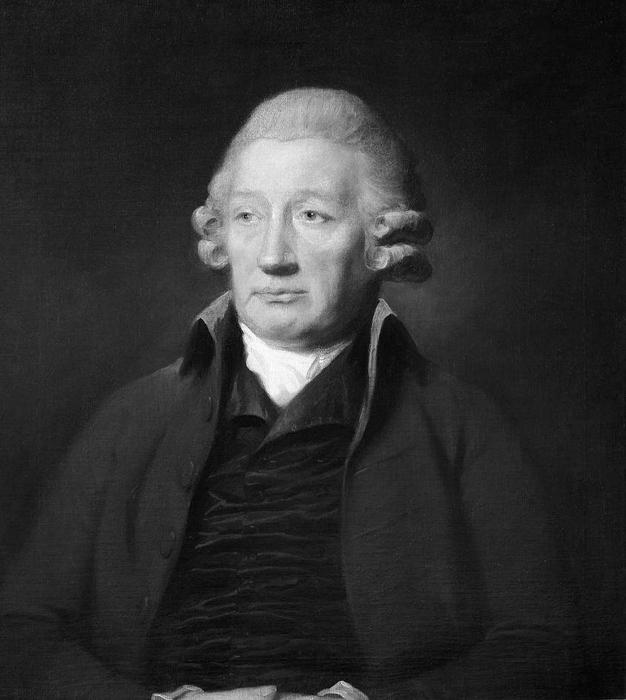
John “Iron-Mad” Wilkinson, whose patent for boring cannon barrels for James Watt marked both the beginning of the concept of precision and the birth of the Industrial Revolution.
John Wilkinson was born into the iron trade. His father, Isaac, originally a Lakeland shepherd, discovered by fortuitous chance the presence of both ore and coal on his pastures and so became in time an ironmaster, a trade very much of its time. The word describes the owner of a family of furnaces, and one who used them to smelt and forge iron from its ore with either charcoal (which stripped England of too-large tracts of forest) or (as an environmentally responsible response) coal that had been half burned and transmuted into coke. John himself, uncomfortably born, it was said, bumping along in a market cart while his mother was en route to a country fair, became fascinated by white heat and molten metal and the whole process of taking mere rocks that lay underground and creating useful things simply by violently heating and hammering them. He learned the trade at the various places in the English Midlands and the Welsh Marches where his father settled down, and was sufficiently adept that by the early 1760s, by now married into money and owning a considerable foundry in the Welsh-English borderland village of Bersham, he began in earnest the production, according to the firm’s first ledger, of “calendar-rolls, malt mill rolls, sugar rolls, pipes, shells, grenades and guns.” It was the final item on the list that would give the tiny village of Bersham, along with the man who would become its most prosperous resident and its largest employer, a unique place in world history.
Bersham, which lies in the valley of the River Clywedog, enjoys an indisputable though half-forgotten role both in the founding of the Industrial Revolution and in the story of precision. For it is here that on January 27, 1774, John Wilkinson, whose local furnaces, all fired by coal, were producing a healthy twenty tons of good-quality iron a week, invented a technique for the manufacture of guns. The technique had an immediate cascade effect very much more profound than those he ever imagined, and of greater long-term importance, I would argue, than the much more famed legacies of his friend and rival Abraham Darby III, who threw up the still-standing great Iron Bridge of Coalbrookdale that attracts tourist millions still today, and is regarded by most modern Britons as the Industrial Revolution’s most potent and recognizable symbol.
Wilkinson filed a patent, Number 1063—it was still quite early in the history of British patents, which were first issued in 1617—with the title “A New Method of Casting and Boring Iron Guns or Cannon.” By today’s standards, his “new method” seems almost pedestrian and an all-too-obvious improvement in cannon making. In 1774, however, a time when naval gunnery all over Europe was enjoying a period of sudden scientific improvement in both technique and equipment, Wilkinson’s ideas came as a godsend.
Up until then, naval cannons (most particularly the thirty-two-pound long gun, a standard on first-rate ships of the line in the Royal Navy, often ordered a hundred at a time when a new vessel was launched) were cast hollow, with the interior tube through which the powder and projectile were pushed and fired preformed as the iron was cooling in its mold. The cannon was then mounted on a block and a sharp cutting tool advanced into it at the end of a long rod, with the idea of smoothing out any imperfections on the tube’s inner surface.
The problem with this technique was that the cutting tool would naturally follow the passage of the tube, which may well not have been cast perfectly straight in the first place. This would then cause the finished and polished tube to have eccentricities, and for the inner wall of the cannon to have thin spots where the tool wandered off track. And thin spots were dangerous—they meant explosions and bursting tubes and destroyed cannon and injuries to the sailors who manned the notoriously dangerous gun decks. The poor quality of early eighteenth-century naval artillery pieces led to failure rates that decidedly alarmed the sea lords at Admiralty headquarters in London.
Then came John Wilkinson and his new idea. He decided that he would cast the iron cannon not hollow but solid. This, for a start, had the effect of guaranteeing the integrity of the iron itself—there were fewer parts that cooled early, for example, as would happen if there was a form installed to create the inner tube. A solid cylindrical chunk of iron, heavy though it might have been, could, if carefully made, come out of the Bersham furnaces without the air bubbles and spongy sections (“honeycomb problems,” as they were called) for which hollow-cast cannon were then notorious.
Yet the true secret was in the boring of the cannon hole. Both ends of the operation, the part that did the boring and the part to be bored, had to be held in place, rigid and immovable. That was a canonical truth, as true today as it was in the eighteenth century, for to cut or polish something into dimensions that are fully precise, both tool and workpiece have to be clasped and clamped as tightly as possible to secure immobility. Moreover, in the specific case of gun barrels, there could be no allowable temptation for the boring tool to wander while the bore was being made. This was the reason the cannons were cast solid rather than hollow. To do otherwise was to risk explosive catastrophe.
In the first iteration of Wilkinson’s patented process, this solid cannon cylinder was set to rotating (a chain was wrapped around it and connected to a waterwheel) and a razor-sharp iron-boring tool, fixed onto the tip of a rigid base, was advanced directly into the face of the rotating cylindrical workpiece. This created a brand-new hole, straight and precise, as the boring tool was pushed directly into the iron. “With a rigid boring bar and the bearing true,” wrote a recent biographer of Wilkinson’s, somewhat poetically, “accuracy was bound to ensue.” In later versions, it was the cannon that remained fixed and the tool, itself now connected to the waterwheel, that was turned. In theory, and provided that the turning bar itself was rigid; that it was supported at both ends and so maintained its rigidity; and that, as it was advanced into the hole it was boring into, the cylinder face did not bend or turn or hesitate or waver in any way, a hole of great accuracy could be created.
Indeed, that is just what was obtained. Cannon after cannon tumbled from the mill, each accurate to the measurements the navy demanded, each one, once unbolted from the mill, identical to its predecessor, each one certain to be the same as the successor that would next be bolted onto it. The new system worked impeccably from the very start, encouraging Wilkinson to apply for and indeed receive his famous patent.
Instead of an eccentrically drilled-out version of a previously cast hole in a cannon barrel that was already peppered with flaws and weak spots, and which, if it fired at all, would hurl the ball or chain shot or shell wildly through the air, the Royal Navy now received from the Bersham works wagonloads of guns that had a much longer shelf life and would fire their grapeshot or canister shot or explosive shells exactly at their intended target. The improvements were all thanks to the efforts of John Wilkinson, ironmaster. Already a wealthy man, Wilkinson prospered mightily as a result: his reputation soared, and new orders flooded in. Soon, his ironworks alone were producing fully one-eighth of all the iron made in the country, and Bersham was firmly set to be a village for the ages.
Yet what elevates Wilkinson’s new method to the status of a world-changing invention, and Bersham’s consequent elevation from the local to the world stage, would come the following year, 1775, when he started to do serious business with James Watt. He would then marry his new cannon-making technique, though this time without a brand-new patent, incautiously, with the invention that Watt was just then in the throes of completing, the invention that would ensure that the Industrial Revolution and much else besides and beyond were powered by the cleverly harnessed power of steam.
The principle of a steam engine is familiar, and is based on the simple physical fact that when liquid water is heated to its boiling point it becomes a gas. Because the gas occupies some 1,700 times greater volume than the original water, it can be made to perform work. Many early experimenters realized this. A Devon-born ironmonger named Thomas Newcomen was the first to turn the principle into a product: he connected a boiler, via a tube with a valve, to a cylinder with a piston, and the piston to a beam on a rocker. Each time steam from the boiler entered the cylinder, the piston was pushed upward, the beam tilted, and a small amount of work (a very small amount) could be performed by whatever was on the far end of the beam.
Newcomen then realized he could increase the work by injecting cold water into the steam-filled cylinder, condensing the steam and bringing it back to 1/1,700 of its volume—creating, in essence, a vacuum, which enabled the pressure of the atmosphere to force the piston back down again. This downstroke could then lift the far end of the rocker beam and, in doing so, perform real work. The beam could lift floodwater, say, out of a waterlogged tin mine.
Thus was born a very rudimentary kind of steam engine, almost useless for any application beyond pumping water, but given that early eighteenth-century England was awash with shallow mines that were themselves awash with water, the mechanism proved popular and useful to the colliery community. The Newcomen engine and its like remained in production for more than seventy years, its popularity beginning to lessen only in the mid-1760s, when James Watt, who was then employed making and repairing scientific instruments six hundred miles away at the University of Glasgow, studied a model of its workings closely and decided, in a series of moments of the purest genius, that it could be markedly improved. It could be made efficient, he thought. It could possibly be made extremely powerful.
And it was John Wilkinson who helped to make it so—once, that is, Watt had had his strokes of the purest genius. These can be summed up simply enough. For weeks, alone in his rooms in Glasgow, Watt puzzled over a model of the Newcomen engine, a machine famed for being so woefully inadequate, so inefficient, so wasteful of all the heat and energy expended upon it. Watt, patiently trying out various ways to improve on Newcomen’s invention, is reported to have remarked wearily that “Nature has a weak side, if only we can find it out.”
He finally did so, according to legend, one Sunday in 1765, as he was taking a restorative walk through a park in central Glasgow. He realized that the central inefficiency of the engine he was examining was that the cooling water injected into the cylinder to condense the steam and produce the vacuum also managed to cool the cylinder itself. To keep the engine running efficiently, though, the cylinder needed to be kept as hot as possible at all times, so the cooling water should perhaps condense the steam not in the cylinder but in a separate vessel, keeping the vacuum in the main cylinder, which would thus retain the cylinder’s heat and allow it to take on steam once more. Moreover, to make matters even more efficient, the fresh steam could be introduced at the top of the piston rather than the bottom, with stuffing of some sort placed and packed into the cylinder around the piston rod to prevent any steam from leaking out in the process.
These two improvements (the inclusion of a separate steam condenser and the changing of the inlet pipes to allow for the injection of new steam into the upper rather than the lower part of the main cylinder)—improvements so simple that, at this remove, they seem obvious, even though, to James Watt in 1765, they were anything but—changed Newcomen’s so-called fire-engine into a proper and fully functioning steam-powered machine. It became in an instant a device that in theory could produce almost limitless amounts of power.
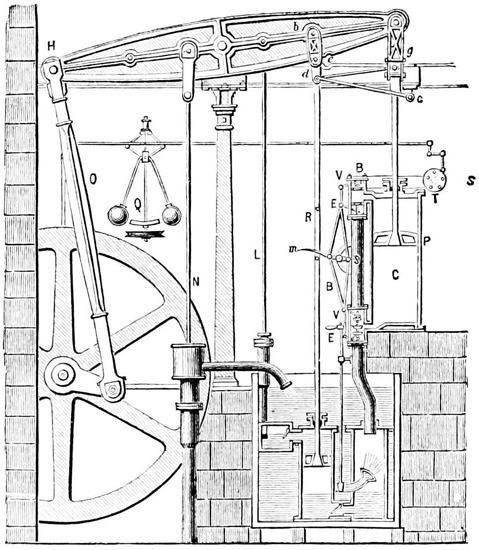
A cross section of a late eighteenth-century Boulton and Watt steam engine. The main cylinder, C, would have been bored by John Wilkinson, the piston, P, fitting snugly inside it to the thickness of an English shilling, a tenth of an inch.
As he began what would be a full decade of testing and prototype building and demonstrating and seeking funds (during which time he moved south from Scotland to the vibrantly industrializing purlieus of the English Midlands), Watt sought and was swiftly awarded a patent: Number 913 of January 1769. It had a deceptively innocuous title: “A New Invented Method of Lessening the Consumption of Steam and Fuel in Fire-Engines.” The modest wording belies the invention’s importance: once perfected, it was to be the central power source for almost all factories and foundries and transportation systems in Britain and around the world for the next century and more.
What is especially and additionally noteworthy, though, is that a historic convergence was in the making. For, living and working nearby in the Midlands, and soon to produce a patent himself (the already noted Number 1063 of January 1774, an exact one hundred fifty patents and exactly five years later than James Watt’s), was no less an inventor than John Wilkinson, ironmaster.
By then, Wilkinson’s amiable madness was making itself felt throughout the ferrous community: all came to learn that he had made an iron pulpit from which he lectured, an iron boat he floated on various rivers, an iron desk, and an iron coffin in which he would occasionally lie and make his frightening mischief. (Women were in plentiful attendance, despite his being a somewhat unattractive man with a massively pockmarked face. He had a vigorous sex drive, fathering a child at seventy-eight by way of a maidservant, a calling of which he was inordinately fond. He kept a seraglio of three such women at one time, each one unaware of the others.)
Still, Wilkinson could and would free himself from these distractions, and by 1775, he and Watt, though of very different temperaments, had met and befriended each other, though it was a friendship based more on commerce than affection. Before long, their two inventions were, and to their mutual commercial benefit, commingled. Wilkinson’s “New Method of Casting and Boring Iron Guns or Cannon” was married to Watt’s “New Invented Method of Lessening the Consumption of Steam and Fuel in Fire-Engines.” It was a marriage, it turned out, of both convenience and necessity.
James Watt, a Scotsman renowned for being pessimistic in outlook, pedantic in manner, scrupulous in affect, and Calvinist in calling, was obsessed with getting his machinery as right as it could possibly be. While he was making and repairing and improving the scientific instruments in his workshop in Glasgow, he became well-nigh immured by his passion for exactitude, to much the same degree as had John Harrison in his clock-making workshop in Lincolnshire. Watt was quite familiar with the early dividing engines and screw thread cutters and lathes and other instruments that were then helping engineers take their first tentative steps toward machine perfection. He was accustomed to instruments that were carefully built and properly maintained, and that worked as they were intended to. He was mortally offended, then, when things went wrong, when inefficiencies were compounded, and when the monster iron engines he was now trying to build in the giant Boulton and Watt factory in Soho performed less well than the brass-and-glass models on which he had experimented back up in Scotland.
His first prototype large engines were spectacular behemoths: thirty feet tall, with a main steam cylinder four feet in diameter and six feet long, a coal-fired boiler, and a separate steam condenser, all massive. All the working parts were connected by a convoluted spiderweb of brass pipes and well-oiled valves and levers, with a spinning two-ball governor that prevented runaways. Above it all was a heavy wooden beam that rocked back and forth with metronomic regularity, turning a huge iron flywheel that in turn worked a pump that gushed water or compressed air or performed other tasks fifteen times a minute. Once at full power, the engine produced a concatenation of noise and heat and a juddering, thudding, stomach-churning intensity that somehow seemed an impossible consequence of merely heating water up to its natural boiling point.
Yet everywhere, perpetually enveloping his engine in a damp, hot, opaque gray fog, were billowing clouds of steam. It was this, this scorching miasma of invisibility, that incensed the scrupulous and pedantic James Watt. Try as he might, do as he could, steam always seemed to be leaking, and doing so not stealthily but in prodigious gushes, and most impudently of all, it was doing so from the engine’s enormous main cylinder.
He tried blocking the leak with all kinds of devices, things, and substances. The gap between the piston’s outer surface and the cylinder’s inner wall should, in theory, have been minimal, and more or less the same wherever it was measured. But because the cylinders were made of iron sheets hammered and forged into a circle, and their edges then sealed together, the gap actually varied enormously from place to place. In some places, piston and cylinder touched, causing friction and wear. In other places, as much as half an inch separated them, and each injection of steam was followed by an immediate eruption from the gap. This is where the blocking came in: Watt tried tucking in pieces of linseed oil–soaked leather; stuffing the gap with a paste made from soaked paper and flour; hammering in corkboard shims, pieces of rubber, even dollops of half-dried horse dung. A solution of sorts came when he decided to wrap the piston with a rope and tighten what he called a “junk ring” around the compressible rope.



